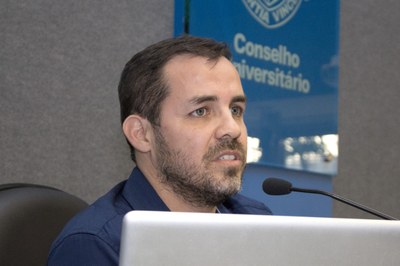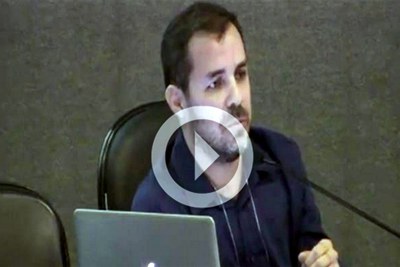René Nome talks about Molecular Dynamics in Short-Lived Phenomena
The scientific and technological advances that have enabled us to observe molecular dynamics in real-time were discussed by René Nome in the conference Playing with Time in Chemistry, held on April 20 in the first round of expositions on the theme “Time” at the Intercontinental Academia (ICA).
Nome, a professor at the Chemistry Institute of the State University of Campinas (UNICAMP), conducts research with ultrafast spectroscopy in the field of femtochemistry, focused on the study of physicochemical phenomena that take place in very short time intervals, on the order of femtoseconds (a unit of measurement corresponding to 10-15 second – or a millionth of a billionth of a second).
In his presentation, he talked about the challenges of investigating the behavior of molecules during chemical reactions, as they involve very small structures and very fast processes. He explained that, when studying this type of phenomenon, “seeing is believing” and, therefore, one must use special optical instruments, based on ultrashort laser pulses, lasting 1 femtosecond. These instruments work like photographic cameras with very high temporal resolution, and are able to capture images of extremely fleeting events, such as transition states and molecular vibration and rotation.
FORERUNNERS
Nome emphasized that research with ultrafast spectroscopy only reached its current stage thanks to the contributions of scientists who laid down the foundation for today’s techniques and technologies, especially Ahmed Zewail, Nobel Prize in Chemistry in 1999, and Eric Betzig, William Moerner and Stefan Hell, Nobel Prizes in Chemistry in 2014.
Related material |
|---|
Zewail, considered the father of femtochemistry, was honored for his pioneering research studies that made it possible to observe the transition states of chemical reactions by means of femtosecond spectroscopy. The study for which he was given the Nobel Prize was highly innovative and used ultrashort laser pulses to capture images of what happens when chemical bonds break down and new ones are created. That was the birth of the world’s fastest camera, capable of photographing atoms and molecules in motion over the course of a chemical reaction as if in slow motion.
Fifteen years later, Betzig, Moerner and Heel were awarded for the development of high-resolution fluorescence microscopy, which enhanced microscopy’s capacity of observation to the nano scale. Previously, it was believed that maximum optical resolution was limited to half the wavelength of light. The technique developed by these researchers broke that barrier and made it possible to visualize, in real time, chemical processes within living cells and at the molecular level, giving rise to nanoscopy.
The trio’s findings were the starting point for numerous studies and paved the way for us to observe the creation of synapses in nerve cells, for instance, or investigate proteins involved in diseases such as Parkinson’s and Alzheimer’s.
DEVELOPMENTS
 In the wake of the forerunners of femtochemistry and nanoscopy, Nome has been conducting studies in the field of ultrafast spectroscopy to understand the role of the environment in highly unpredictable physicochemical processes.
In the wake of the forerunners of femtochemistry and nanoscopy, Nome has been conducting studies in the field of ultrafast spectroscopy to understand the role of the environment in highly unpredictable physicochemical processes.
He spoke in depth about one study in particular, which observed at the molecular level the mechanisms and the transfer of energy during photosynthesis, considered one of the fastest processes ever recorded by man.
The project aims to understand how solar energy migrates from the “antenna complex” to the reaction centers where photochemistry takes place, that is, how a molecule absorbs sunlight and transfers the energy as quickly as possible to another, distant molecule. To this end, Nome uses ultrashort laser pulses, whose main advantage is its monochromatic character, indicative of a high degree of temporal coherence. In other words, the phases of the light waves are synchronized, so that photons travel together in time, in the same frequency.
According to Nome, the data obtained so far help explain the absorption efficiency of photosynthetic light and its transduction into energy.

